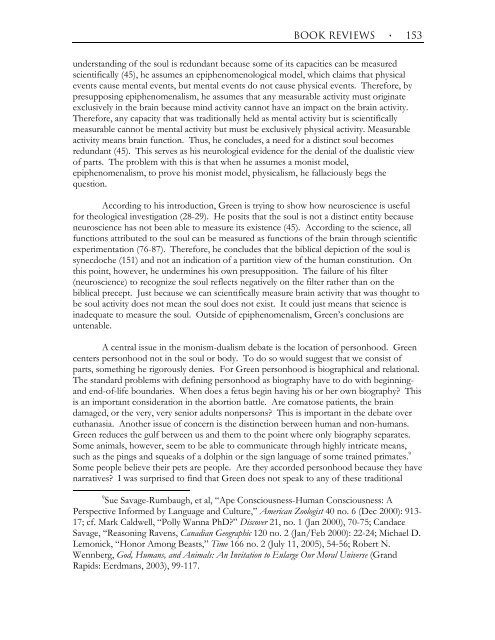0 jbtm vol. 6, no. 2 the proclamation of the gospel - Baptist Center for ...
0 jbtm vol. 6, no. 2 the proclamation of the gospel - Baptist Center for ...
0 jbtm vol. 6, no. 2 the proclamation of the gospel - Baptist Center for ...
You also want an ePaper? Increase the reach of your titles
YUMPU automatically turns print PDFs into web optimized ePapers that Google loves.
BOOK REVIEWS ٠ 153<br />
understanding <strong>of</strong> <strong>the</strong> soul is redundant because some <strong>of</strong> its capacities can be measured<br />
scientifically (45), he assumes an epiphe<strong>no</strong>me<strong>no</strong>logical model, which claims that physical<br />
events cause mental events, but mental events do <strong>no</strong>t cause physical events. There<strong>for</strong>e, by<br />
presupposing epiphe<strong>no</strong>menalism, he assumes that any measurable activity must originate<br />
exclusively in <strong>the</strong> brain because mind activity can<strong>no</strong>t have an impact on <strong>the</strong> brain activity.<br />
There<strong>for</strong>e, any capacity that was traditionally held as mental activity but is scientifically<br />
measurable can<strong>no</strong>t be mental activity but must be exclusively physical activity. Measurable<br />
activity means brain function. Thus, he concludes, a need <strong>for</strong> a distinct soul becomes<br />
redundant (45). This serves as his neurological evidence <strong>for</strong> <strong>the</strong> denial <strong>of</strong> <strong>the</strong> dualistic view<br />
<strong>of</strong> parts. The problem with this is that when he assumes a monist model,<br />
epiphe<strong>no</strong>menalism, to prove his monist model, physicalism, he fallaciously begs <strong>the</strong><br />
question.<br />
According to his introduction, Green is trying to show how neuroscience is useful<br />
<strong>for</strong> <strong>the</strong>ological investigation (28-29). He posits that <strong>the</strong> soul is <strong>no</strong>t a distinct entity because<br />
neuroscience has <strong>no</strong>t been able to measure its existence (45). According to <strong>the</strong> science, all<br />
functions attributed to <strong>the</strong> soul can be measured as functions <strong>of</strong> <strong>the</strong> brain through scientific<br />
experimentation (76-87). There<strong>for</strong>e, he concludes that <strong>the</strong> biblical depiction <strong>of</strong> <strong>the</strong> soul is<br />
synecdoche (151) and <strong>no</strong>t an indication <strong>of</strong> a partition view <strong>of</strong> <strong>the</strong> human constitution. On<br />
this point, however, he undermines his own presupposition. The failure <strong>of</strong> his filter<br />
(neuroscience) to recognize <strong>the</strong> soul reflects negatively on <strong>the</strong> filter ra<strong>the</strong>r than on <strong>the</strong><br />
biblical precept. Just because we can scientifically measure brain activity that was thought to<br />
be soul activity does <strong>no</strong>t mean <strong>the</strong> soul does <strong>no</strong>t exist. It could just means that science is<br />
inadequate to measure <strong>the</strong> soul. Outside <strong>of</strong> epiphe<strong>no</strong>menalism, Green’s conclusions are<br />
untenable.<br />
A central issue in <strong>the</strong> monism-dualism debate is <strong>the</strong> location <strong>of</strong> personhood. Green<br />
centers personhood <strong>no</strong>t in <strong>the</strong> soul or body. To do so would suggest that we consist <strong>of</strong><br />
parts, something he rigorously denies. For Green personhood is biographical and relational.<br />
The standard problems with defining personhood as biography have to do with beginning-<br />
and end-<strong>of</strong>-life boundaries. When does a fetus begin having his or her own biography? This<br />
is an important consideration in <strong>the</strong> abortion battle. Are comatose patients, <strong>the</strong> brain<br />
damaged, or <strong>the</strong> very, very senior adults <strong>no</strong>npersons? This is important in <strong>the</strong> debate over<br />
euthanasia. A<strong>no</strong><strong>the</strong>r issue <strong>of</strong> concern is <strong>the</strong> distinction between human and <strong>no</strong>n-humans.<br />
Green reduces <strong>the</strong> gulf between us and <strong>the</strong>m to <strong>the</strong> point where only biography separates.<br />
Some animals, however, seem to be able to communicate through highly intricate means,<br />
such as <strong>the</strong> pings and squeaks <strong>of</strong> a dolphin or <strong>the</strong> sign language <strong>of</strong> some trained primates. 9<br />
Some people believe <strong>the</strong>ir pets are people. Are <strong>the</strong>y accorded personhood because <strong>the</strong>y have<br />
narratives? I was surprised to find that Green does <strong>no</strong>t speak to any <strong>of</strong> <strong>the</strong>se traditional<br />
9 Sue Savage-Rumbaugh, et al, “Ape Consciousness-Human Consciousness: A<br />
Perspective In<strong>for</strong>med by Language and Culture,” American Zoologist 40 <strong>no</strong>. 6 (Dec 2000): 913-<br />
17; cf. Mark Caldwell, “Polly Wanna PhD?” Discover 21, <strong>no</strong>. 1 (Jan 2000), 70-75; Candace<br />
Savage, “Reasoning Ravens, Canadian Geographic 120 <strong>no</strong>. 2 (Jan/Feb 2000): 22-24; Michael D.<br />
Lemonick, “Ho<strong>no</strong>r Among Beasts,” Time 166 <strong>no</strong>. 2 (July 11, 2005), 54-56; Robert N.<br />
Wennberg, God, Humans, and Animals: An Invitation to Enlarge Our Moral Universe (Grand<br />
Rapids: Eerdmans, 2003), 99-117.


